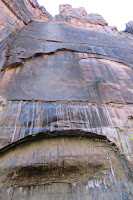 |
| Zion Canyon in the morning |
The final stop among the Utah Five required another pre-dawn start, this time from the cold, quiet blocks of Panguitch. If you sit on heading to Zion National Park, odds are you will ending up standing in long lines.
The park road doesn’t allow for speed, nor should anyone want to race through these vistas. The mountains, formations and mesas look like fortresses carved from red sandstone.
The Zion-Mt. Carmel Highway is an engineering marvel once its reaches the park, hugging canyon walls and then going under the mountain to enter central Zion. First come a few short tunnels, the big one, a 1.1-mile plunge into darkness save for six large windows cut through the sandstone for viewing the outside valley. At one time stopping was allowed at the windows, but the park’s volume of visitors makes that impossible. The tunnel isn’t the longest part of the drive, but it feels like it. Like Arches,
Zion is a not a massive park, and the biggest attractions are crowd magnets. The visitor center parking lot already had a “Full” sign but further inspection showed it had several rows of open spots left. We grabbed one and headed directly for the canyon shuttle. At 8 a.m., the shuttle had no wait, just a short walk to an open bus.
The full bus reduced its stops for the fall, with some attractions like Weeping Rock closing. Not only were the fall colors still changing around Zion, but some aspens still had healthy green leaves. In the river, shed leaves floated with the currents.The bus enters Zion Canyon almost immediately after leaving the park highway, and the wonders don’t cease for the entire 6-mile route. The Three Patriarchs, formations named for Old Testament prophets, stun even as the opposing canyon wall still threw off shadows.
 The road curves around Angels Landing, the infamous and strenuous two-mile climb know for its narrow ledges and deep drop-offs. A man on the bus told us he hiked to the Angels Landing trail overlook and decided against it. When I was in my thirties, I considered that hike, but it stands out of reach these days.
The road curves around Angels Landing, the infamous and strenuous two-mile climb know for its narrow ledges and deep drop-offs. A man on the bus told us he hiked to the Angels Landing trail overlook and decided against it. When I was in my thirties, I considered that hike, but it stands out of reach these days.
The road ends at Temple of Sinawava, named for the Paiute coyote god. It’s also the jump-off point for those seeking to hike The Narrows, the skinniest part of Zion Canyon just a mile up the Virgin River. On a November day, Narrows hikers were east to spot in their waterproof boots, waders and walking sticks. Hikers must walk in the river, which has a rocky bottom and covers 4-plus miles up to Big Springs.
 |
| Weeping rock |
The paved trail ran all the way to The Narrows, but a network of sandy paths along the river kept calling. Since we weren’t hiking The Narrows, we had no reason to walk to its entrance, which was surely crowded with hikers.
The wind that pushed me the whole way up the canyon stopped the instant we turned to walk along the floodplain on the way back. Here the Virgin River really comes alive, an oasis in the desert preserved by ample shade from its steep-walled canyon. Islands of grass, quaking aspens and other trees were past peak but many still had leaves. Turquoise pools and swift currents moved the Virgin across its rocky bed. Floods on this same river helped make Zion into a geologic rarity.
The canyon stayed cool as the sun could not reach its bottom till late morning. Ravens and other birdsongs emerged as the sun migrated down the canyon walls.
Time didn’t allow for a trip out to the Kolob Canyons , formerly a separate national monument later incorporated into Zion. By this point in the trip, sensory overload from the continuous geologic marvels had firmly taken hold. As our mostly empty bus rumbled up to the visitor center depot, the crowds had caught up with us. At 11 a.m., people cruised the lot for open parking spaces. Someone asked and we let them have ours.
Unlike Arches, the Zion-Mt. Carmel Highway is a through-road, so they cannot close access as easily. The road up from the Virgin River became crazed. Every overlook overflowed with cars. People ignored no-parking signs to park, and filled slow vehicle turnouts as well.
Everyone got a little mean, me included. Fighting for one spot or less than a full spot or coming to a complete stop in the road to look for a spot at every lookout felt foolish to me. But I know nothing about what drives other people.
The issue persisted on the tunnel’s other side, all the way to the park border. A few empty spots at the Checkerboard Mesa overlook could not compel me to stop. There was simply too much soaring sandstone in Zion's early morning to process anything else.
 |
| Virgin River in Zion Canyon |


No comments:
Post a Comment